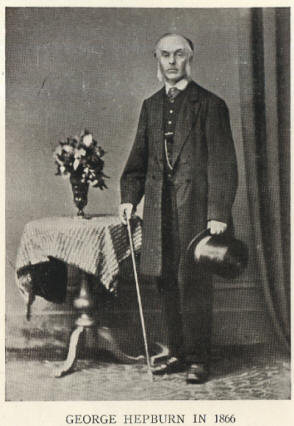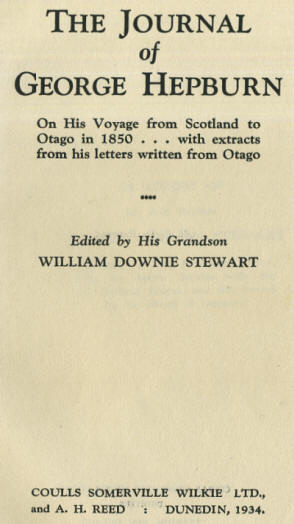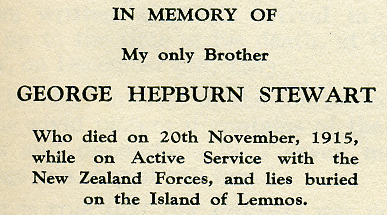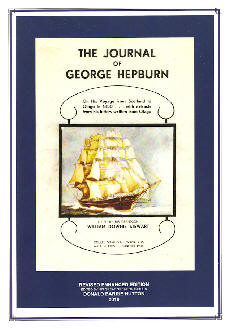


Preface
THE
first part of this small volume contains the
journal of my grandfather, George Hepburn, who came from Fifeshire,
Scotland, to Otago in the year 1850 in the sailing ship Poictiers.
The second part consists
of extracts from letters written after his arrival in Otago and up to
the time of his death, at the age of 81, on December 9th, 1883.
The chief interest of the
journal consists in the vivid picture it contains of the hardships and
discomforts of a seven months’ voyage in a ship of 756 tons.
It is true that the
Poictiers was not one of the pioneer ships, for between 1848 and 1850
twelve previous emigrant vessels arrived at Otago; all being of smaller
tonnage than the Poictiers. No doubt there are in existence
accounts of these earlier voyages, but I do not know of any narrative
which records the day-by-day events of life on a sailing ship of that
period so faithfully and vividly as does this journal.
From time to time there
crop up throughout the journal the strong national antipathies and
prejudices of a Scotchman of those days against the English on his first
contact with them after leaving his native country. This national
hostility may amuse—but will not surprise—those readers who are familiar
with the novels of Sir Walter Scott.
The Otago settlement was
founded by the Free Church of Scotland. It is not surprising, therefore,
that its first settlers were for the most part men of deep religious
conviction and of a stern Calvinistic type. To some extent these
characteristics reveal themselves in this journal. My grandfather’s
passion for the strict observance of the Sabbath prompted him on the
long voyage to act as a censor of the morals and behaviour of his fellow
passengers. Nothing induced him to relax the rigidity of his strict
code, whether the ship was running before a fierce gale or its
passengers and crew were sweltering in the heat of the tropics. But the
reader must not infer from these evidences of the stricter standards of
by-gone days that my grandfather was a dour and sour-visaged bigot. He
was a man of kindly and genial disposition, who loved hospitality, and
welcomed festive gatherings in his home at Halfway Bush, near Dunedin.
The journal is also of
permanent interest because of the early glimpses it gives of various New
Zealand settlements—New Plymouth, Nelson, and Wellington—which were
ports of call en route to Otago.
George Hepburn was born
in 1803 in the Scotch town of Kirkcaldy, the birthplace of the famous
economist Adam Smith. [In his Life of Adam Smith Lord Haldane
says: "Kirkcaldy, or, as the name was spelt in the days of Adam Smith,
Kirkaldy, is a manufacturing town on the north side of the Firth of
Forth. From its peculiar characteristic of possessing great length
without breadth it has for generations enjoyed the appellation of the
lang toon.’ The inhabitants are of that shrewd hardheaded nature for
which Fife is famous. Manufacture overshadows agriculture, and the
general aspect of the place is that of Industry."]
At the time when with his
wife and eight children he reached Dunedin, after a voyage of seven
months, the settlement had already been in existence for two years. His
letters give many interesting glimpses of the business, social, and
religious life of the small community and of its steady growth and
development up till the time of his death.
My grandfather was a
member of the Provincial Council of Otago from 1855 to 1865, and
for some time he served as Chairman of Committees in the Council. He
also represented the electoral district of Roslyn in the fourth New
Zealand Parliament from 1866 to 1868 as a supporter of the Stafford
Ministry, but retired on the ground of ill-health.
The following extract
from the Otago Witness of 15th December, 1883, gives some further
particulars of his life which may be of interest to the reader.
The place of another of the old
worthies of Otago has become vacant, thus still further narrowing the
circle of the devoted band of early settlers who struggled hard against
difficulties, which can neither be known nor appreciated by the present
generation. On September 1st, 1850, Mr. Hepburn arrived at the Port of
Otago in the ship Poictiers (Captain Beal) after a seven months’
voyage from London, being accompanied by his wife and a large family.
Accustomed in his native land to indoor occupation, the prospects of
making a living for his family and himself in the midst of his strange
surroundings was not inviting. In Dunedin he saw no opening in the trade
which he had at his finger-ends—there were already too many pursuing it
for the small population. However, he did not give way to despondency
and, although of not a robust constitution, he bravely faced the
difficulty, and having secured a section of land at Halfway Bush he,
with a will and with the help his young family could afford, tackled the
arduous task of clearing the bush and making his ground yield out of its
richness sustenance for his household.
Aboyt six months afterwards Mr.
Macandrew arrived (1851) and, the services of a competent and
trustworthy general manager and salesman being required, the position
was offered to and accepted by Mr. Hepburn, and in this employ he
remained until 1855 when, in conjunction with Mr. James Paterson, be
purchased the business from Messrs. Macandrew and Co. and carried it on
under the firm or style of Jas. Paterson and Co. for several years very
successfully, until he retired to more private life. Even with all the
comfort of metalled roads and different conveyances, the daily journey
to and from Dunedin to Halfway Bush, especially in wintry weather, does
not possess many attractions, so some idea may be formed of the pluck
needed to perform the journey, seven days in the week, in all weathers,
through bush, scrub, and swamp, with scarcely a track to guide his
footsteps.
Keenly alive to his responsibility
for the exercise of his religious duties, which were ingrained in him in
youth and practised in manhood’s prime, he at once attached himself to
First Church under the ministry of Dr. Burns, and on Sabbath, 16th
March, 1851 having previously been elected thereto by the members of the
Church, he was inducted as an Elder for the Halfway Bush district, and
for several years he was also Session Clerk in the First Church
congregation. (He had formerly been an Elder in the Free Church,
Kirkcaldy.) He had for his colleague in the Deacon-ship the late James
Marshall, who had in the Home Country been a Deacon of the Free Church
of Falkirk, continuing in connection with First Church until the opening
of Knox Church in 1860, when he was appointed as one of the interim
Session in its formation. He remained in that position, and was the
last survivor of its first Session. In both churches he zealously
devoted himself to those labours in which his heart delighted.
The subsequent erection of Wakari
into a separate charge, being in Mr. Hepburn’s own neighbourhood,
received his warm support and active assistance.
The politics of the Province
received from Mr. Hepburn a considerable amount of attention and,
although not a "heaven-born orator," he possessed the rarer attribute of
commonsense, and showed it as occasion required. In 1855 he was returned
at the top of the poll as one of the representatives of Wakari District
in the second Provincial Council, and continued a member for Wakari for
several Councils, and for a considerable period occupied the difficult
position of Chairman of Committees. The still higher position of a
member of the Assembly was conferred on him in 1866, the constituency of
Roslyn returning him as their member against two other candidates. At
the close of the Parliament of 1871 [He resigned in 1868] he did not
again offer himself for a seat in the House.
Warmly alive to the advantages of
education, he gave his assiduous attention to the school requirements of
his district, occupying the position of Chairman of the School
Committee.
In editing these papers I have
purposely refrained from any attempt to condense the narrative. It is no
doubt true that on a prolonged sea voyage there is much that must appear
trivial and monotonous, but after several perusals of the journal I
reached the conclusion that only by reading the detailed day-by-day
record can the reader appreciate the arduous and exacting nature of such
a voyage. Moreover, the real charm of both journal and letters lies in
the quaint and homely language and the artless simplicity of the style.
The papers were written by my
grandfather without any idea that one day they would be published.
Indeed they were found some years ago almost by accident buried away in
a box in an old house in Scotland.
Hence my first plan was merely to
render them available to the third and fourth generations of his
descendants; but owing to their intrinsic historical interest I have
ventured to think that they may appeal to a wider circle of readers.
I am indebted to Dr. Scholefield,
Parliamentary Librarian, and to Mr. Alfred Eccies for references to
various people and places; and to the Librarians of the Free Public and
Hocken Libraries and the Secretary of the Early Settlers’ Association,
Dunedin, for assistance in the selection of illustrations.
WM. DOWNIE STEWART.
DUNEDIN, 28th November, 1934
CONTENTS

It gives me great pleasure to
announce the publication of a revised, enhanced edition of
The
Journal of George Hepburn
Those of you who are familiar with
William Downie Stewart’s 1934 edition (A5, 204pp) will know that
it comprised two parts:
Part I: George Hepburn’s
complete 1850 ship’s journal
Part II: “Letters from
Otago.” William Downie Stewart selected some of letters George Hepburn
wrote to family back in Britain from 1850 until his death in 1883. These
were presented under topical chapter headings, rather than in
chronological order.
+ + +
The 2010 edition (A4,
174pp) comprises 4 parts:
Part I: The ship’s journal
(36pp)
Part II: The letters (39pp)
Parts I and II have been retained
in the 1934 format with some minor editing plus additional footnotes and
illustrations. A number of the greyscale illustrations Stewart included
were taken from old paintings. These are now in full colour.
Part III: The previously
unpublished letters and documents not used by Stewart (74pp).
Part III is a chronological
transcription taken directly from the original letters. It retains
Hepburn’s unique spelling, grammar, paragraphing, highlighting,
underlining, superscripts, cross outs and other writing characteristics,
insofar as this was possible to achieve when transcribing from
handwritten 19th
Century documents to a 21st
century computer word processing programme.
Index: People, places,
ships, events (7pp)
+ + +
Some features of the 2010 edition:
-
Provides a wider insight into
the unique personality of George Hepburn
-
Gives intimate details of sad
and joyous events which affected family life in early Otago
-
Records the growth of Dunedin
from a small pioneer settlement to a thriving commercial centre of
national importance
-
Describes how Hepburn and his
wider family contributed to community, educational, church,
political and business affairs
-
Doubles the content of the
1934 edition
-
There are 40 additional
illustrations, many in colour
-
Examples of the original
handwritten documents
-
Includes hundreds of footnotes
explaining terms and identifying individuals, places and events
-
A comprehensive index has been
added
+ + +
Editor: Donald Barrie
Hutton, BA, Dip Ed, Dip Tchg. b.1938. Great great grandson of George
Hepburn. Family Historian. Retired Education Review Officer, Secondary
School Inspector, Guidance Counsellor, History Teacher.
+ + +
Initially, I am offering The
Journal of George Hepburn (2010) to direct descendants at $NZ30 plus
$NZ5 P & P. If you wish to obtain a copy please send a cheque (crossed)
or money order for $NZ35 to me at the address below.
Mr. D.B. Hutton,
197 Highsted Road,
Casebrook,
Christchurch 8051,
New Zealand
Note: If you live outside New Zealand we'd
suggest emailing Don Hutton
to get a quote as shipping to other countries will cost more. |

